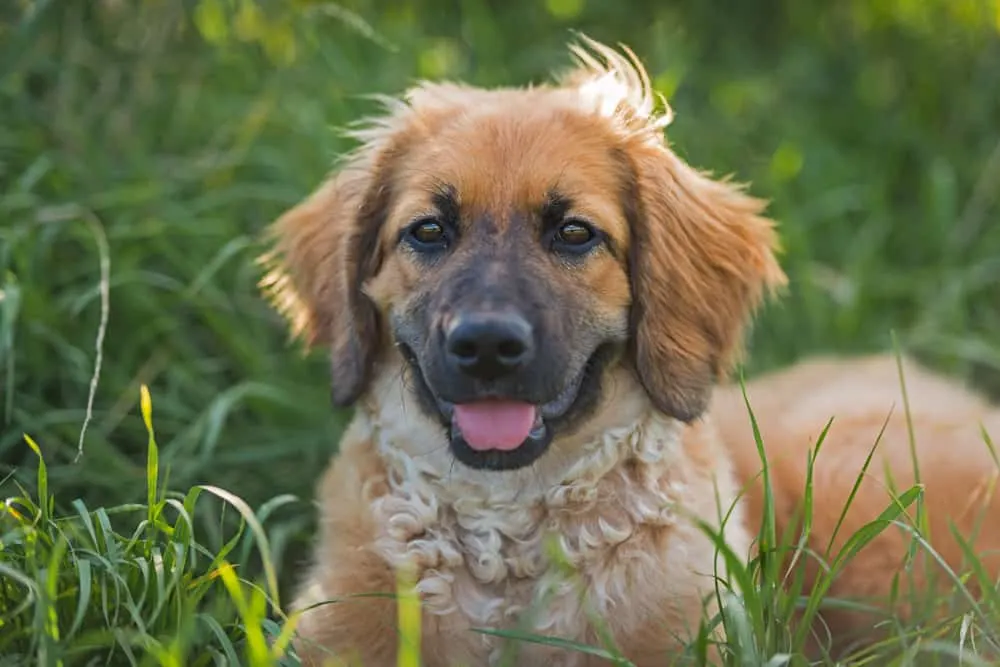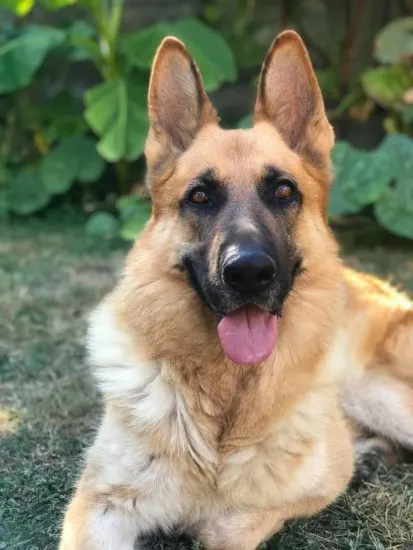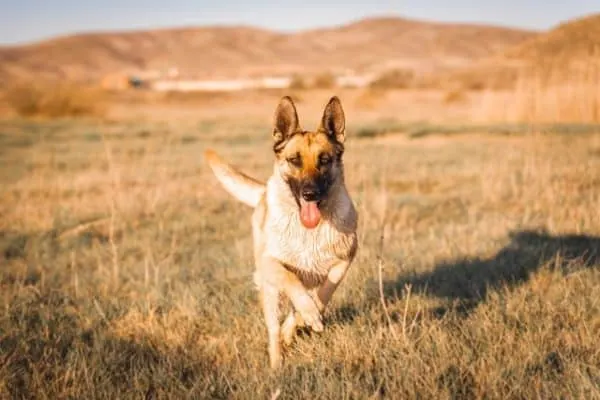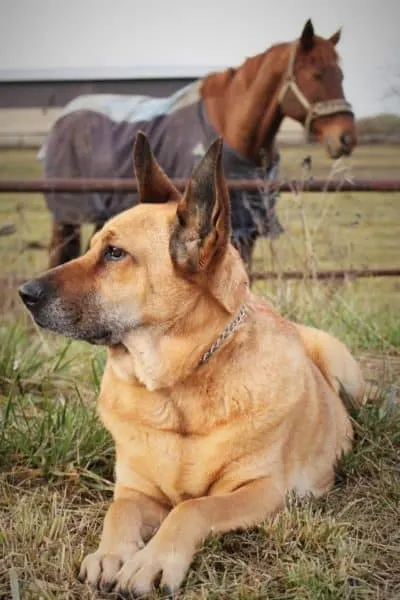Blonde German Shepherd: Meet This Beautifully Colored GSD!
The blonde German Shepherd has a very unusual coat color for this popular companion canine.
In fact, in many cases, a puppy might be born with a very light coat color that looks blonde – to the point where inexperienced breeders might think the dog is going to be blonde-coated.
But then as that puppy grows up, the coat color can change dramatically. This is why a truly blonde German Shepherd dog as an adult is so rare.
How can an adult German Shepherd even inherit a blonde coat?
We will talk about dog coat color genetics and much more in this article.

Blonde German Shepherd
The blonde German Shepherd is not a different breed of Shepherd dog. Rather, when a dog is referred to as a blonde German Shepherd, the reference is purely in regard to the dog’s adult coat color.
As the American Kennel Club (AKC) points out, what is most interesting about a blonde coat on a purebred German Shepherd dog is that this color is not on the list of recognized coat colors for the breed.
We will talk a lot more about why that is in this article.
How Could a German Shepherd Dog Inherit a Blonde Coat?
Since blonde technically is not recognized as a coat color for German Shepherd adult dogs, how on earth could a GSD even grow up to be blonde?
This question catapults us into the mystery of the canine genome and dog color genetics.
As VCA Animal Hospitals explains, dog coat color genetics actually starts out fairly simple.
There are two main pigments that contribute to creating a dog’s adult coat color. Those two pigments are eumelanin and phaeomelanin.
Eumelanin is the basic black pigment. Phaeomelanin is the basic red pigment.
Seems easy enough, right?
This is exactly where things start to get more complicated.
There are actually several other genes that can influence or act on eumelanin and phaeomelanin to produce different color shades and color patterns.
Eumelanin in German Shepherd Dog Coats
Take basic black, for example. Eumelanin in its pure form is going to be dark black. But eumelanin can be changed if another gene changes it.
Liver German Shepherd coat
Basic black might then become liver, a pale brown color – and one that could easily be mistaken for blonde.
In fact, liver is one of the AKC-recognized and registered coat colors for the German Shepherd dog.
Sable German Shepherd coat
Basic black might also become sable, which is a pattern that includes dark or black tips at the ends of the hairs.
Sable is an AKC-recognized and registered coat pattern for adult German Shepherd purebred dogs.
On the Pedigree Database user forum, you can see some great photos of German Shepherd puppies with blonde coats that eventually grew up to have the sable coat color pattern.
Agouti German Shepherd coat
As JMA Design Frankenhaus German Shepherd breeder points out, some GSD breeding books do make reference to agouti as a possible coat color pattern for the German Shepherd dog.
Agouti did not make the official American Kennel Club (AKC) breed coat color list, however.
Agouti is not just one color pattern, either. It is sometimes referred to as “wolf color” and wolves’ coats do not all look the same.
But they mostly all have the same basic coat with the dark hair tips and lighter color closer into the wolf’s body.
One possible coloration that may come from the agouti variations – six in all – is golden.
But here, golden occurs because the puppy is actually sable or very light grey, and the coat simply lightens to the point where it looks blonde.

Phaeomelanin in German Shepherd Dog Coats
In the case of basic red, it is actually this color spectrum that can lighten to produce a basic blonde coat color.
As Dog Coat Colour Genetics points out, phaeomelanin can range all the way from a very light gold or tan, all the way up to a deep burnished red.
While red is an AKC-recognized and registered part of the black and red bicolor coat pattern for German Shepherd dogs, red on its own is not present on that list.
Tan is another recognized secondary color in the black and tan coat pattern for purebred adult German Shepherd dogs, but tan on its own is not present on that list.
At this point, you may be be wondering how it could even be possible for a blonde German Shepherd adult dog to exist.
Let’s find out.
German Shepherd Puppies Often Change Coat Colors
People who are brand-new to dog breeding typically don’t know that many puppies will be born with one coat color, and grow up to have a different coat color.
In some cases, such as with the German Shepherd dog breed, that coat color transition from puppyhood to adulthood can be rather dramatic.
As South Florida Shepherds breeder highlights in their photo gallery, sometimes the color change can also be quite subtle. It really depends on the individual puppy’s genes.
Decoding this mystery starts with understanding that puppies don’t keep their puppy coat when they grow up.
In fact, this transition from puppy coat to adult dog coat can start at as early as six months of age!
As the BirchBark Foundation rescue organization outlines, there are a number of factors that can influence whether a puppy’s coat will change color, and how much it might change.
In addition to canine genetics, which is the principal driving factor, an adult German Shepherd dog’s coat color may be influenced by:
- diet
- medications
- overall health
- access to natural sunlight
- skin conditions
- and other factors as well

What Happens to the Coat When a GSD Puppy Grows Up?
When a puppy starts to transition from a puppy coat to the adult dog coat, the first thing that happens is that the puppy coat begins to fall out.
Here, this process is not unlike how the baby teeth fall out and the adult teeth grow in behind them.
The single-layer puppy coat may fall out in stages as it is steadily replaced by the double-layer adult German Shepherd dog coat.
Not all dog breeds have a double layer coat, but most German Shepherd dogs (the long coat type excepting) do have this layer.
The inner coat layer is typically a solid color. It is barely visible because it is covered by the coarser, longer outer coat layer. The undercoat only has one purpose: to keep the dog warm.
The outer layer of the GSD coat, in contrast, serves many functions. It has to protect the dog from wet conditions, the cold, sunburn, pests, abrasions, injuries, and more.
The outer layer might be a solid color, a bi-color (two-color pattern), or a multi-color pattern such as sable.
Experienced breeders are often able to predict with a great degree of certainty what coat color a GSD puppy will grow up to display.
However, because canine genetics are so complicated, even the most experienced breeders can occasionally be surprised.
This is exactly what can happen when a blonde German Shepherd appears!
How Does a Blonde German Shepherd Coat Even Happen?
There are several possibilities that can end up leading to a blonde German Shepherd or at least a blonde-appearing German Shepherd.
Remember when we talked about how the phaeomelanin color pigment can have different appearances, depending on how other genes may interact with it?
Phaeomelanin can lighten to the point where it is a very light blonde that can be mistaken for white.
A blonde GSD coat may actually be white
White coats are produced by the absence of color pigment altogether. However, in certain types of light, a blonde coat can appear white and vice versa.
So it may just be that the dog actually has a white coat.
While white is another unusual and rare color in German Shepherds, unlike blonde, white is also a color that is recognized in the GSD breed standard.
A blonde GSD may actually be rare but possible
At one point, nearly every purebred dog breed we recognize and love today was once a hybrid or mixed-breed dog.
Purebred dog breeds are developed by strategic crossbreeding.
In the case of German Shepherds, a former German cavalry officer named Captain Max von Stephanitz used a dog of unknown origin that had suspected wolf-dog genes to create the breed.
Along the way, the Captain occasionally crossed his new emerging breed with other German herding dogs.
It’s quite possible that some of these other dog breeds may have carried the genes for a blonde coat.
The human understanding of the full canine genome is still quite young.
Since documentation of the other herding dogs used by Captain von Stephanitz is incomplete, it’s impossible to say that there is no blonde dog in the breed’s history.
A blonde GSD is actually a hybrid or mixed dog breed
Hybrid dog breeding is becoming quite popular today as more breeders take steps to create new dog breeds.
One day, some of these hybrid dog breeds may become registered purebred breeds in their own right.
But until then, it is really important to learn as much as you can about a dog breeder’s pedigree and operation before you make a lifetime commitment to a GSD puppy.
There are several reasons for this. The first, and most important, is because you want to avoid buying a GSD puppy from a puppy mill.
Puppy mills are in dog breeding for the profit and do not do health testing or provide the parent dogs or puppies with a proper diet and nutrition.
These dogs may not even be legitimate purebred German Shepherds.
Speaking of health, the second reason is that German Shepherds do have some heritable health issues.
Only a reputable breeder that tracks their dogs’ genetics will be able to produce healthy puppies free from known testable genetic diseases.
The third reason is that if a breeder does not track their lineage, you have no way of knowing if your dog is even a true purebred GSD.
This is most important if you plan to show your dog or breed German Shepherds yourself.
But it is also important for the other reasons we just mentioned here.

What to Know Before Choosing a Blonde German Shepherd Dog
Now that you have a much deeper understanding of all the types of factors that may result in an adult blonde German Shepherd coat, you may wonder if it is a good idea to choose a blonde GSD.
The truth is, the best way to choose a companion canine is always to work with a reputable, health-focused, responsible dog breeder who tests their parent dog pairs for all known genetic health issues.
This is how you can make sure your puppy will be born as healthy as possible.
Coat color should always be secondary to health.
As long as your German Shepherd comes from good genes, there is nothing to worry about in choosing a dog that has a less-common coat color like the blonde German Shepherd.
Frequently Asked Question
Are blonde German shepherds rare?
Yes, blonde German shepherds are rare. However, there are many people that do own them.
In order to have a blonde German Shepherd, you will need to breed dogs that have the correct genes, as this is not the typical color.
A blonde German shepherd will have a coat that is very similar in color to a yellow Labrador and a Golden retriever.
It is a truly beautiful color for a German shepherd, and often people may not even register that the dog is a GSD at first glance.
These types of GSD are the same as any other type, the only difference is in the color and rarity of their coat. Given that they are not overly popular, within the GSD community, they are fairly sought after.
While this color of German shepherd is not accepted at shows, they are a beautiful color to own.
See a Blonde German Shepherd Dog
In this video, you can get a good idea of the coat coloration of the blonde German Shepherd on a fully grown adult dog.
You’ll also notice how the coat can seem lighter or darker in certain types of lighting. Just as with humans, there can be many shades of color in the blonde spectrum for canines.
However, at some point, a true blonde may cross over in adulthood to become a liver or even a shade of gray.






























